Session 11 – Rules of the Road 4
RULES OF THE ROAD cont.
OTHER LANE CONTROLS
Shared Center Lane
Shared center lanes are reserved for making left turns (or U-turns when they are permitted) by vehicles traveling in either direction. On the pavement, left-turn arrows for traffic in one direction alternate with left-turn arrows for traffic coming from the other direction.
These lanes are marked on each side by solid yellow and dashed yellow lines. Be sure you enter the lane only if it is safe to do so.
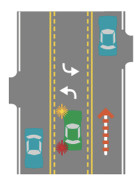
Reversible Lanes
Some travel lanes are designed to carry traffic in one direction at certain times, and in the opposite direction at other times. These lanes are called “reversible lanes” and are usually marked by double-dashed yellow lines.
Before you start driving in them, check to see which lanes you can use at that time. There may be signs posted by the side of the road or overhead. Special lights are often used. A green arrow means you can use the lane beneath it; a red “X” means you cannot. A flashing yellow “X” means the lane is only for turning. A steady yellow “X” means the use of the lane is changing and you should move out of it as soon as it is safe to do so.
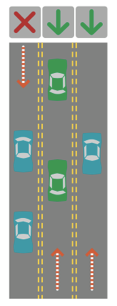
Reserved Lanes
On various roadways, one or more lanes may be reserved for special vehicles. Reserved lanes are marked by signs stating the lane is reserved for special use. They often have a white diamond posted at the side of the road and/or painted on the road surface. It is illegal to travel in one of these lanes unless operating that type of vehicle, or unless you must turn across the reserved lane in the next half of a block.
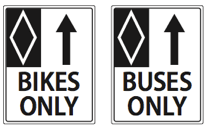
“Transit” or “buses” means the lane is for bus use only. “Bikes” means the lane is reserved for bicycles.
High Occupancy Vehicles (HOV) lanes are reserved for car pools and vehicles with more than one person in them. Signs say how many people must be in the vehicle as well as the days and hours to which it applies. For example, “HOV 4” means there must be at least four people in the vehicle.
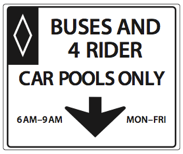
METERED RAMPS
Metered Ramps
Ramp meters are traffic signals on freeway entrance ramps. They more evenly space the number of vehicles merging with traffic already on the freeway. This helps to reduce congestion and the stop-and-go traffic flow at freeway entrance points.
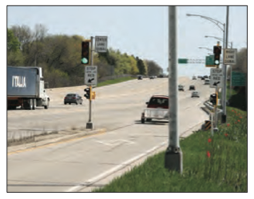
How to Use a Ramp Meter
A. Ramp Meter Warning Sign
As you enter a metered ramp, you will see a “Ramp Metered When Flashing” sign.
If the sign’s yellow light is not flashing, you can merge into traffic without stopping or slowing down.
Metered Ramps
Ramp meters are traffic signals on freeway entrance ramps. They more evenly space the number of vehicles merging with traffic already on the freeway. This helps to reduce congestion and the stop-and-go traffic flow at freeway entrance points.
If the sign’s yellow light is flashing, it means the ramp meter is operating. You should follow these steps when the ramp meter is operating.
B. Regular Traffic Lanes
Choose a traffic lane.
C. HOV Lane
Certain vehicles can use the High Occupancy Vehicle (HOV) bypass lane on the ramp. HOV lanes are for any vehicle with two or more people, or motorcycles, buses and emergency vehicles. HOVs must still obey the traffic signal in their dedicated lane. Generally, HOV lanes have little or no waiting. If you are traveling alone, you can be ticketed for using that lane.
D. Stop Line and Signals
At the ramp signal, you should pull completely up to the white stop line so your tires will trigger the sensors in the pavement to change the light from red to green. Each lane on the ramp has its own traffic signal. The traffic signals will alternate between green and red. They will allow one vehicle to pass through for each green light. You should not try to squeeze through with someone else during one change to green. If you disobey a ramp signal, you can be ticketed.

Other Features
To keep traffic on the ramp from backing up onto local streets, sensors in the pavement will detect if a long line of vehicles is forming on the ramp. The sensor will trigger a computer to speed up the green light. This will shorten the wait time at the ramp meter. Cameras installed on the ramps help to monitor traffic flow or, if needed, to assist emergency personnel in responding to a crash.
